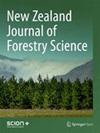希腊黑松(Pinus nigra J.F.Arnold)无性系种子园心材数量遗传参数及其化学性状
IF 1.1
4区 农林科学
Q2 FORESTRY
引用次数: 0
摘要
背景:黑松(Pinus nigra J.F.Arnold)是南欧、地中海地区和希腊木材生产中产量最高的针叶树物种之一。近年来,由于其药用特性,人们对其心材提取物含量的兴趣再次高涨。黑松可用于生产高附加值产品,如由木材和木材废料生产的生物活性化合物。方法:在希腊伯罗奔尼撒建立的一个44年生的黑松无性系种子园中,对心材化学性状和心材百分比进行了定量遗传参数估计。在克隆平均基础上,总丙酮提取物的遗传力极高,除左旋海松酸(0.47)外,所有树脂酸的总树脂酸(≥0.85)非常高,总二苯乙烯、皮诺钾盐脱氢枞酸和心材百分比(0.69-0.79)非常高。在个体基础上,全丙酮提取物的基因控制为中高(0.53-0.62),大多数树脂酸的总树脂酸(≥0.85),脱氢枞酸的值较低(0.39),而左旋海松酸的值很低(0.15),樟子松及其醚衍生物的心材百分比在个体基础上表现出较低的遗传力(0.31-0.43)。总丙酮提取物和总二苯乙烯之间的表型相关性(rp)为负弱(≤-0.173)和显著(p≤0.01),而遗传相关性(rg)为中到强(≤-0.502)显著(p≤0.01)中-强(0.529-0.975)和遗传相关性(0.583-0.975。心材百分比与其化学性状之间的表型和遗传相关性是正的(在大多数情况下是显著的),除了脱氢枞酸和左海松酸。结论:所研究的克隆包括克隆种子园,可用于克隆林业和随后的育种周期,表明其具有很高的高级育种潜力,尤其是具有高药用和经济价值的心材提取物。本文章由计算机程序翻译,如有差异,请以英文原文为准。
Quantitative genetic parameters of heartwood and its chemical traits in a black pine (Pinus nigra J.F.Arnold) clonal seed orchard established in Greece
Background: Black pine (Pinus nigra J.F.Arnold) is one of the most productive conifers species for timber production in southern Europe, the Mediterranean region and Greece. Recently, the interest for its heartwood extractives content due to their medicinal properties has been renewed. Black pine can be used to produce high added value products, such as bioactive compounds produced from wood and wood waste materials.
Methods: Quantitative genetic parameters were estimated for heartwood chemical traits and heartwood percentage in a 44-year-old Pinus nigra clonal seed orchard, established in Peloponnese, Greece.
Results: Significant variation was found among clones and among provenances for all studied traits. Heritability on a clone mean basis was extremely high for total acetone extractives, total resin acids as for all resin acids (≥0.85), except levopimaric acid (0.47) and very high for total stilbenes, pinosylvins as for dehydroabietic acid and heartwood percentage (0.69-0.79). On an individual basis, the genetic control was moderate to high (0.53-0.62) for total acetone extractives, total resin acids as for most of resin acids (≥0.85) with dehydroabietic acid presenting low value (0.39) while levopimaric acid very low (0.15). Total stilbenes, pinosylvins and its ether derivatives as heartwood percentage exhibited low values of heritability on individual basis (0.31-0.43). The phenotypic correlation (rp) between total acetone extracts and total stilbenes was negatively weak (≤-0.173) and significant (p≤0.01) while the genetic correlation (rg) was moderate to strong (≤-0.502). The rp values between several pinosylvins were significantly (p≤0.01) moderate to strong (0.529-0.975) as were genetic correlations (0.583-0.975). Between the studied resin acids, both rp and rg values were mostly medium to strong (rp≥0.8 and rg≥0.7) and significant (p≤0.01) in the case of phenotypic correlations, with minor exceptions (levopimaric acid). Phenotypic and genetic correlations between heartwood percentage and its chemical traits were positive (being in most cases significant), except for dehydroabietic and levopimaric acid.
Conclusions: The studied clones, comprising the clonal seed orchard, can be used in clonal forestry and subsequent breeding cycles, indicating high potential for advanced breeding, especially for heartwood extractives that are of high pharmaceutical and economic value.
求助全文
通过发布文献求助,成功后即可免费获取论文全文。
去求助
来源期刊

New Zealand Journal of Forestry Science
FORESTRY-
CiteScore
2.20
自引率
13.30%
发文量
20
审稿时长
39 weeks
期刊介绍:
The New Zealand Journal of Forestry Science is an international journal covering the breadth of forestry science. Planted forests are a particular focus but manuscripts on a wide range of forestry topics will also be considered. The journal''s scope covers forestry species, which are those capable of reaching at least five metres in height at maturity in the place they are located, but not grown or managed primarily for fruit or nut production.
 求助内容:
求助内容: 应助结果提醒方式:
应助结果提醒方式:


